What is the type of one kilogram coffee roaster? How to master the roasting technology of coffee beans?

Professional coffee knowledge exchange more coffee bean information please follow the coffee workshop (Wechat official account cafe_style)
What is the type of one kilogram coffee roaster? How to master the roasting technology of coffee beans?
First of all, I would like to declare that this is my experience, and it is not objective, because very few people can change the core component of the bean baking machine [baking bucket] from semi-hot air to direct fire bucket under the same structure and system, and then make a comparison.
This is not a conjecture, but my personal demonstration, and through the process and results of this demonstration, we can finally get rid of the framework of foreign arguments, after all, their foundation is based on hot air and semi-hot air, whether it is Scott Rao, Rob Hoos, Tim Wendelboe, Willem Boot, Joe Marocco, or the winners of WCRC, SCAE, etc., I try very hard to stand on their shoulders at a small price and thank them. Thanks to the borderless network, I have really gained a lot.
Once upon a time, I naively thought that when I bought a bean baker, there was no opening in the body of the baking bucket, so it could only be fed through the mesh at the bottom of the bucket. If the ventilation was not enough, I would change the fan to the fire row if I felt that the firepower was too weak, and the differential pressure meter would be used as an assistant. I have a semi-hot fan that can use hot air as the main source of baking heat. In fact, I just have a bean dryer that simply purifies the air into the baking bucket, which is still a long way from the degree of the semi-hot fan.
In the process, no one will tell me, nor have I seen you discuss related issues. after all, the machines that most people buy are completed, and for similar money, I don't even have a fire chop, and I have to assemble the DIY002 by myself, and the hidden DIY blood makes me fall in love with this machine as soon as I try it. I didn't even consider it, and I placed an order in the middle of the night that day. Also because they have been assembled many times, they are really familiar with the structure of their machines, adjust bit by bit, and carry out non-destructive transformations. as long as the baked beans are found in doubt, or well-founded discussion, they will find a way to prove it. until you confirm that your machine can achieve what kind of state of the semi-hot fan, what kind of furnace operation method can be used to achieve the goal you want to challenge.

After that stage, there is no hope for semi-hot fans, even for the world's top famous brands. After all, it is impossible for them to enter the coffee industry and do not need any machines that can stabilize mass production. It is time to study another more complex type of baking beans, that is, straight-fire baking.
In fact, every time you participate in a bug sharing meeting in Atti, you can drink bugs and other advanced straight-fire baked products, of which bug coffee is the most distinctive and highly recognizable, and that characteristic flavor, I call it [bug flavor], and bugs always say, that is the taste of straight-fire baking. The bug is good at using barrel speed at different stages to create the flavor of coffee. for a machine of 1 to 2 kilograms, the speed range can be changed from 10 to more than 100 revolutions per minute. If you add air conditioning and fire adjustment, the spectrum created is so large that it is hard to imagine.
I often drink coffee with at least three flavor levels after the entrance. I personally try my best to use all the theories I have learned and try to get close to that level, but I have never reached it. Well, I can blame it that there must be a bug roaster to reach that level, because a lot of things cannot be simply summarized and restored. And in retrospect at this point, perhaps, straight fire is really an answer. Direct fire can do what semi-hot air cannot do, that is, the high-temperature heat of the flame, instantly heating part of the tissue of beans.
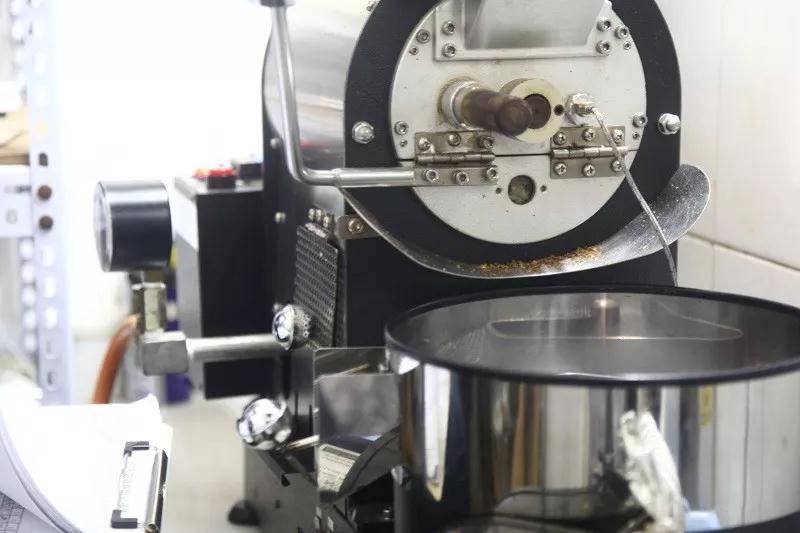
Putting aside the difficult theories such as Mena reaction, caramelization reaction and high temperature pyrolysis reaction, according to the experience of contact with food in daily life, the aroma and taste produced by high temperature barbecue are always the most prominent. For coffee, as long as you overcome three problems, direct fire baking will be because of its aroma and taste. Becoming an irreplaceable baking method (uniformity of the whole pot, scorching and overcooked endogenesis are three common defects in direct-fire baking).
The problem of the uniformity of the whole pot is caused by the improper design of the rotating speed of the drum and the mixing blade, the coke burning is caused by the rapid heating of firepower and fire when heating the drum and beans, and the endogenesis is caused by the rapid heating when the thermal energy intensity is higher than the thermal conductivity and thermal diffusion capacity of beans. All forms of bean dryers may have the above defects, but because the direct-fired bean dryers have the most direct fire source and the highest heat, it is most obvious that as long as there are structural defects (for example, the small machine also imitates the large machine fire row directly to the rolling bucket, or the drum blade group is too small, the speed is too slow), or the fire control is too careless, it is easy to destroy a pot of beans.
There is a picture of a semi-hot fan manuscript with a double-pot structure, which is suitable for discussing the straight-fire bean baking machine.
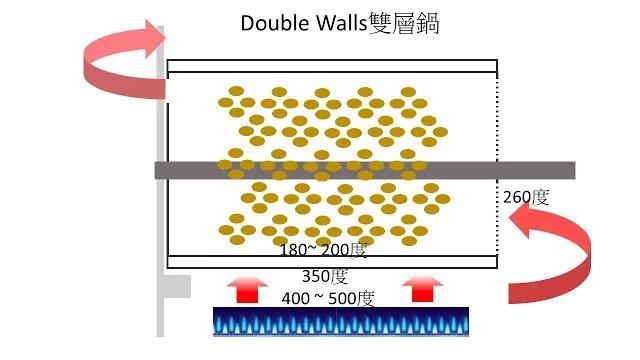
The semi-hot fan of the double-layer boiler body is shown above.
In such a structure, the hot platoon can be heated to 350 degrees for the outer layer of the baking bucket and 260 degrees for the air to be pumped into the baking bucket. because of the double-layer wall structure, the high temperature of the outer pot will not be transmitted directly to the inner pot, keeping the inner pot at a low temperature of 180 and 200 degrees, ensuring that the wall of the pot will not burn beans under any conditions, while ensuring that hot air is the main source of baked beans. Baking beans with uniform, stable, clean and consistent flavor is the design direction of the machine.
If the double-layer pot is replaced with a single-layer thin pot under the same mechanism, as shown below, the firepower of 260 degrees hot air will reach the high temperature of 350 degrees (where the beans are in direct contact). It is really difficult to estimate how much the whole baking rhythm will be improved. it may also produce charred, externally cooked and endogenous beans as a result of heating up too quickly. In order to avoid being too fast, the firepower can only be reduced, so the hot air temperature will decrease accordingly. In the same baking time, the proportion of hot air heat energy eaten by beans to the heat energy of the pot body and the machine of the double pot must be greatly reduced.

Semi-hot fan with single-layer boiler body
The semi-hot air pot with no hole in the barrel body has the above situation. What if the pot is replaced with a direct hot pot full of holes? On the one hand, we should consider the heat of the pot body, but also consider the heat of the flame acting directly on the beans. Where's the hot air? Under the same exhaust air volume, because the air intake area becomes larger, the wind speed into the baking bucket becomes softer, and because the whole barrel body has holes, and some even the bottom of the bucket has holes, the hot air entering the baking bucket simply comes from all directions, and the heat varies, so its hot air effect can not be observed by a single point of intake temperature, and the temperature of the hot air outlet is the only data that can be used for reference.
Back to the heat of the flame acting directly on the beans, it can heat the pot body to 350 degrees, obviously the temperature must exceed 350 degrees, and the effect on the beans is larger than the heating of the beans by the pot body (flame is a kind of high temperature hot gas, beans can be easily covered by convection). Therefore, in a comprehensive consideration, on the basis of the same amount of exhaust air, the hot air baked by direct fire is considered. It's completely different from semi-hot air. In my opinion, put it in the water vapor, smoke on the exclusion of consideration, if the drum speed can not be adjusted (but fast enough), as long as the mind on fire control.
The above is the corollary, and then there is the empirical evidence. The following picture is a schematic diagram of my semi-hot air and direct fire baking.
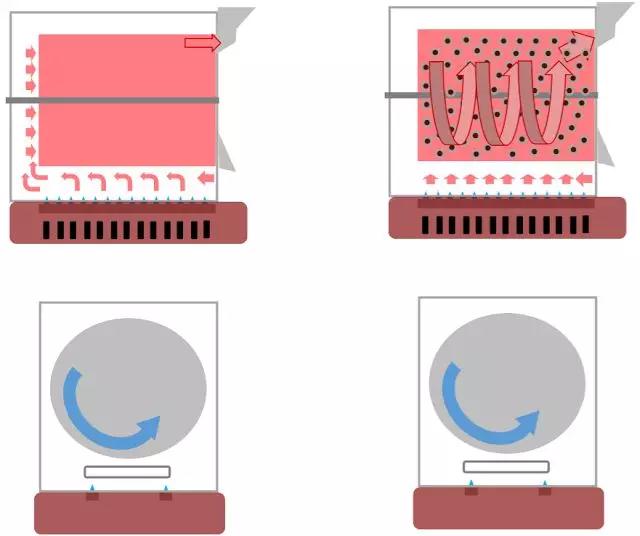
Left half hot air, right straight fire
I control the ventilation according to the reading of the differential pressure meter, in principle, because my semi-hot air structure can not use too much air flow, otherwise the pot will be too hot in order to make the intake air reach the required temperature. I always control the maximum wind pressure so that the size of the silver skin can be completely taken away as the upper limit. After changing to a straight hot pot, I still maintain the same wind pressure control.
Because the fire platoon structure is the same, it can be concluded that under the same wind pressure and the same firepower, the inlet air temperature should also be similar (not the same can only be similar, because there is also the environmental temperature factor). The difference is that the wind speed of the direct fire acting on the beans is lower, and the inlet air temperature is different in different parts. According to the measurement, the wind temperature at the bottom of the beans can reach 475 degrees, while at that time the wind temperature close to the upper half is about 270 degrees. After heat exchange with the beans, the air outlet temperature is about 240 degrees, which is the biggest difference from the inlet air temperature of 270 degrees of semi-hot air and the exhaust air temperature of 240 degrees.
Semi-hot air architecture [Sidamo Lion King]
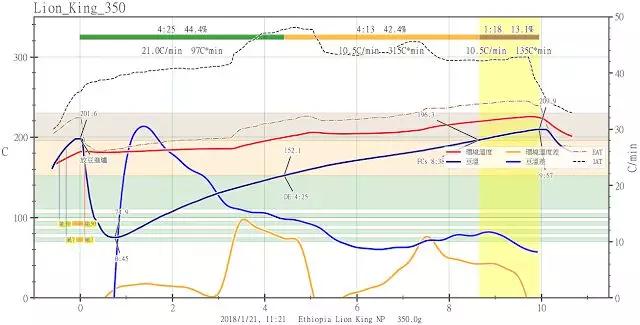
Direct fire architecture [Sidamo Lion King]

Take the same kind of beans (Ethiopian Guji Lion King Sun) in the structure of semi-hot wind and straight fire respectively, baking with similar rhythm and the same development time, the aroma of straight fire is relatively strong, and the taste is relatively thick.
The direct fire because the heating is relatively direct, the impact of firepower adjustment on the curve is also very fast and direct, as long as the internal environment of the roaster is stable (does not change due to changes in the external environment), the exhaust air temperature goes according to the expected temperature, the wind and fire does not need to be adjusted. The heating mode of semi-hot air is more indirect. When the exhaust air temperature is found to be too low, the firepower is increased to increase the air temperature, but it is often found that the response is too slow or the effect is not as good as expected. Therefore, I compare baking a semi-hot hot pot to sailing, which requires a pre-reaction; a straight hot pot is like turning on a GO CART, but the reaction should not be too big.
My conclusion
Due to the high heating temperature of the beans, the aroma created by the direct fire is relatively strong, and because of the rapid response to rising and falling temperatures, after proficiency (for me), it is much more refreshing to bake, which is my experience at this stage.

Understand the design principle of coffee roasting machine
Take the bean baking machine made in Taiwan as an example, during the baking process, the functions that can be controlled are gas firepower, exhaust valve, and boiler speed, while the temperature observation values provided are the bean temperature in the furnace and the temperature of the air outlet. There are bean viewing windows and sampling rods to judge the appearance and smell of raw beans.
The rotating boiler is to let the raw beans be heated evenly, and the good baffle design in the boiler makes it more lively and leaping when stirring, so as to avoid point scald. When the rotational speed is slow, the raw bean is in contact with the boiler for a long time; when the rotation is fast, the raw bean is thrown in the hot air for a long time, both of which will affect the flavor. However, the speed of the boiler cannot be adjusted on the baking machines in Germany, Japan and the United States.
In addition to firepower, the distance between the gas fire row and the boiler, called fire distance, is also a difficult problem in machine design. The modification of the Japanese brand bean dryer is to increase the number of gas nozzles, but the problem of uniform heating is also considered when the fire is farther away. The new machine made in Taiwan changes the design of gas nozzles to three rows and double switches, igniting according to the amount of baking, and increasing the flexibility of operation.
Ignition heating, heat energy through conduction, convection, radiation of these three types of coffee beans have a heating effect.
In addition to the full hot air machine is mainly convective heat, we often hear of semi-hot air and direct fire type of these two machines. To put it simply, the wall of the baking room of the direct-fire bean dryer is perforated to allow the radiant heat to act directly on the raw beans. Such a machine can also be equipped with a far-infrared kit to maximize the effectiveness of the radiant heat.
The semi-hot air machine mainly uses conduction heat and convection heat. When the firepower is fixed, the size control of the exhaust valve is the main factor affecting the convection heat.
Steps to actually operate a coffee roaster
Start the machine, light the fire, wait for the temperature of the boiler to rise to a certain degree, turn off the fire and put the coffee into the raw beans.
At this time, the raw beans at room temperature will have heat exchange with the hot boiler, and it can be observed from the instrument that the boiler temperature will drop, and according to the number of raw beans, the time of heat exchange will increase. Until the heat absorption of raw beans is complete, the temperature of the boiler begins to rise, which is called the "temperature recovery point".
Before the raw beans are put in, whether the fire is turned off or not, everyone has different baking habits, but this will affect the temperature recovery point, so we should pay attention to it.
At first, the temperature will rise faster, but with the yellowing of bean color and the decrease of moisture, the temperature rise will gradually slow down and stabilize. If you use a sampling stick to remove raw beans, you can obviously smell the change in taste, from the astringent taste of grass evaporated to the aroma similar to toast or sweet potato, the silver skin will gradually peel off, and the exhaust valve can be opened moderately. Let the silver skin blow out. Before the first burst, the temperature rises slowly, and the raw beans absorb a lot of heat from the hot air, ready to burst.
From the sporadic burst sound, gradually dense, the temperature rises faster, a large number of smoke is discharged, and then it needs to be vented properly through the exhaust valve. It should be noted that excessive exhaust will lead to excessive convective heat and bad flavor.
Continue to heat, after the first burst sound temporarily, the coffee beans are brewing a second burst, the temperature difference between the two is 25 ℃. When the second burst, the smoke intensified, coffee beans gradually turned dark brown, slightly scorched aroma.
Before dropping the beans, start the cooling plate fan and stir to cool the coffee beans in the shortest possible time to keep the flavor good.
How to achieve stable baking
How to achieve stable baking and replicate the most perfect flavor is the biggest task for every bean baker.
First, use the instrument to detect the water content of raw beans, work out the baking plan curve in advance, and record the data of the baking process in detail as the basis for reference and correction.
Second, use the fixed temperature recovery point as the benchmark to keep the heating curve consistent and avoid unnecessary firepower adjustment and correction.
Third, do a good job in the maintenance and cleaning of the bean baking machine, including dust collection buckets, so that the baking conditions are consistent.
Fourth, carefully choose the location of the bean baking machine to minimize environmental factors, and even the number of baking pots in each batch must be controlled in a certain range to avoid too little or too much.
Roasting coffee beans is a very interesting and challenging job, and the pursuit of perfect ultimate flavor is a goal that can never be stopped.
Important Notice :
前街咖啡 FrontStreet Coffee has moved to new addredd:
FrontStreet Coffee Address: 315,Donghua East Road,GuangZhou
Tel:020 38364473
- Prev
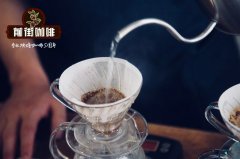
Authentic Blue Mountain Coffee Brand recommendation _ Blue Mountain Coffee Price list _ what is the taste of Blue Mountain Coffee
Professional coffee knowledge exchange more coffee bean information Please pay attention to the coffee workshop (Wechat official account cafe_style) authentic Lanshan coffee beans have mellow, mellow taste, rich, rich, moderate and perfect sour taste, three (sweet, sour, bitter) excellent blending, can make the taste sense more sensitive, taste its unique taste, is the best coffee. . the world-famous Blue Mountain Cafe
- Next
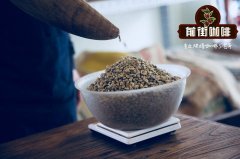
Nanshan Coffee Bean Price _ Super Nanshan Coffee Bean Price list _ Jamaica Blue Mountain Coffee Bean Price
Professional coffee knowledge exchange more coffee bean information please pay attention to the coffee workshop (Wechat official account cafe_style) this rare and precious Jamaica national treasure blue mountain No.1 coffee beans (Wallenford), I think many people know the Blue Mountain coffee, but most drink is the Nanshan flavor coffee, and the authentic blue mountain coffee taste is much different, and play and taste good
Related
- Detailed explanation of Jadeite planting Land in Panamanian Jadeite Manor introduction to the grading system of Jadeite competitive bidding, Red bid, Green bid and Rose Summer
- Story of Coffee planting in Brenka region of Costa Rica Stonehenge Manor anaerobic heavy honey treatment of flavor mouth
- What's on the barrel of Blue Mountain Coffee beans?
- Can American coffee also pull flowers? How to use hot American style to pull out a good-looking pattern?
- Can you make a cold extract with coffee beans? What is the right proportion for cold-extracted coffee formula?
- Indonesian PWN Gold Mandrine Coffee Origin Features Flavor How to Chong? Mandolin coffee is American.
- A brief introduction to the flavor characteristics of Brazilian yellow bourbon coffee beans
- What is the effect of different water quality on the flavor of cold-extracted coffee? What kind of water is best for brewing coffee?
- Why do you think of Rose Summer whenever you mention Panamanian coffee?
- Introduction to the characteristics of authentic blue mountain coffee bean producing areas? What is the CIB Coffee Authority in Jamaica?

